Asparagus densiflorus, A. retrofractus, A. seaceus
Asparagus fern is a member of the lily family, and the Asparagus genus. This evergreen herbaceous perennial bears no resemblance to either, and in spite of its name, is not a true fern.
This is because it sets seed rather than producing spores.
Another contradiction is that what we would typically call leaves are actually “cladodes,” or flattened stem portions. The true leaves are tiny scale-like protrusions you may not even notice.

We link to vendors to help you find relevant products. If you buy from one of our links, we may earn a commission.
Furthermore, this evergreen has two sides to its personality: in USDA Hardiness Zone 9 to 11 gardens, it tends to spread so vigorously that it is considered invasive in Florida, Hawaii, and Texas.
But as a potted plant, it’s a gem!
In this article, you will learn to cultivate some exceptional species and cultivars of this ornamental South African beauty.
Here’s what’s in store:
What You’ll Learn
The many varieties of this plant are characterized by cascading, feathery leaves so airy and light they have an ephemeral quality.
But beware! Beneath mature wispy layers of green are sharp spines to remind you that the dreamy texture is more of an attractive facade.
Note that this plant is toxic to people and pets, and should be kept away from small children.
Cultivation and History
We have evidence of the American cultivation of asparagus fern dating back to the beginning of the last century.
In the December 1, 1900 issue of The Gardeners’ Chronicle, cut bunches are mentioned, and their average wholesale prices are listed.
It arrived in American gardens and flowerpots from its native South Africa via Europe.
Asparagus fern grows in a shrub-like upward fashion, with layer upon layer of delicate branches. Insignificant white blossoms and orange, red, or deep purple berries may appear under ideal conditions.
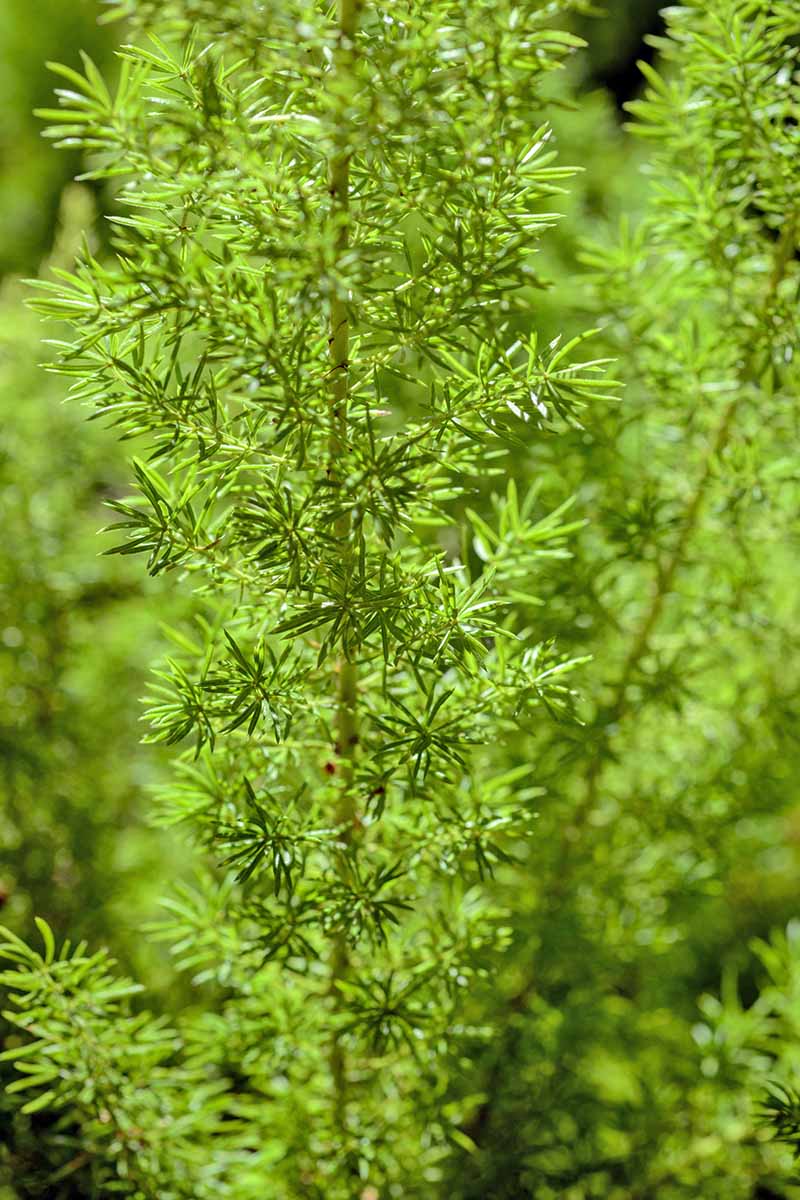
Numerous species grow in the wild, including medicinal A. racemosus and climbing A. africanus, but you won’t generally find these on the market. The types you are most likely to find available for sale are A. densiflorus, A. retrofractus, and A. setaceus.
As I’ve mentioned, asparagus fern is not a true fern. As a matter of fact, it has more in common with edible asparagus, A. officinalis.
Both are herbaceous perennials that require moist, organically-rich soil, but the similarities don’t end there.
They are both dioecious, which means they produce both male and female plants; both types flower, but only the females set fruit.
In addition, both display nondescript scale-like “leaves,” although in the case of asparagus fern, they are actually not leaves but cladodes, as described above.
And finally, while the two species may be grown from seed, it is less challenging and more common to start both from tuberous root cuttings instead.
It’s always a nice surprise to find berries. I’ve even had a few appear on indoor plants. The berries add ornamental interest, and seeds may be saved to start new plants.
And while there’s no way of determining visually if you have a female plant when you purchase it (unless it is actively producing fruit!), you can provide the best possible conditions for fruiting with abundant filtered sunlight and a consistently moist environment.
Outdoor plants grown in warm climates are the most likely to set fruit, and may produce clusters of red or orange berries, which may deepen to a nearly black shade of purple in some cases.

Expect an average mature size of three feet wide with branches about three feet in length. Some types may grow or spread several more feet under optimal conditions.
With excellent care, your plants may reward you with 10 or more years of lush growth.
Propagation
To start your own plant, you’ll need to sow seeds or divide an existing plant.
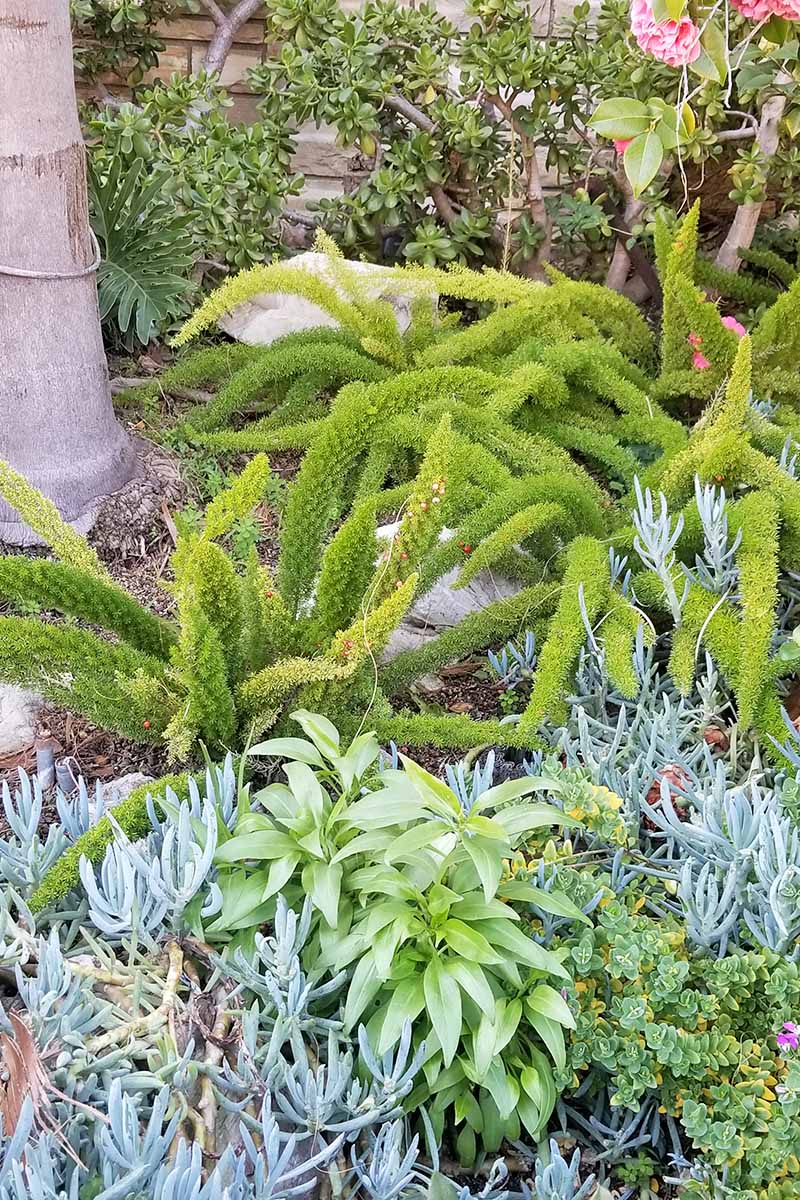
The best time to do both is in early spring.
From Seed
Seeds may be purchased, or you can opt to save your own.
Propagating by this method may be challenging, as there are only one to three seeds per berry, and they don’t always germinate.
When you’re ready to plant your seeds, scrape them gently with sandpaper and soak them in water overnight before sowing. This helps to facilitate germination, by weakening the hard outer coating of the seeds.
If they are too small for you to handle easily, instead of using sandpaper, you could place the seeds in a bag with a little sand and shake them up. Then place the contents of the bag into water, sand and all, to soak for the night.
You may start seeds indoors in egg cartons, seed-starter trays, or grow disks.
Alternatively, you may sow them directly outdoors.
Moisten your potting medium or garden soil, then place the seeds on top and press them down gently. Do not cover the seeds with soil as they need light to germinate.
Place in a location that receives indirect sunlight. Maintain even moisture, watering before the soil dries out completely.
They can take up to four weeks to germinate, so be patient!
By Division
To start a plant by this method, consult our guide to dividing perennials.
A division is obtained by cutting straight down through a mature plant’s rootstock, separating the cut portion, and planting it elsewhere. The roots are essential, as stems alone will not regrow.
Place the division into your choice of potting medium or garden soil, and water well.
Maintain even moisture, watering before the soil dries out completely.
How to Grow
Cultivation is easy, once you know how. Wear gloves to avoid being nicked by thorns, and the rest is smooth sailing.
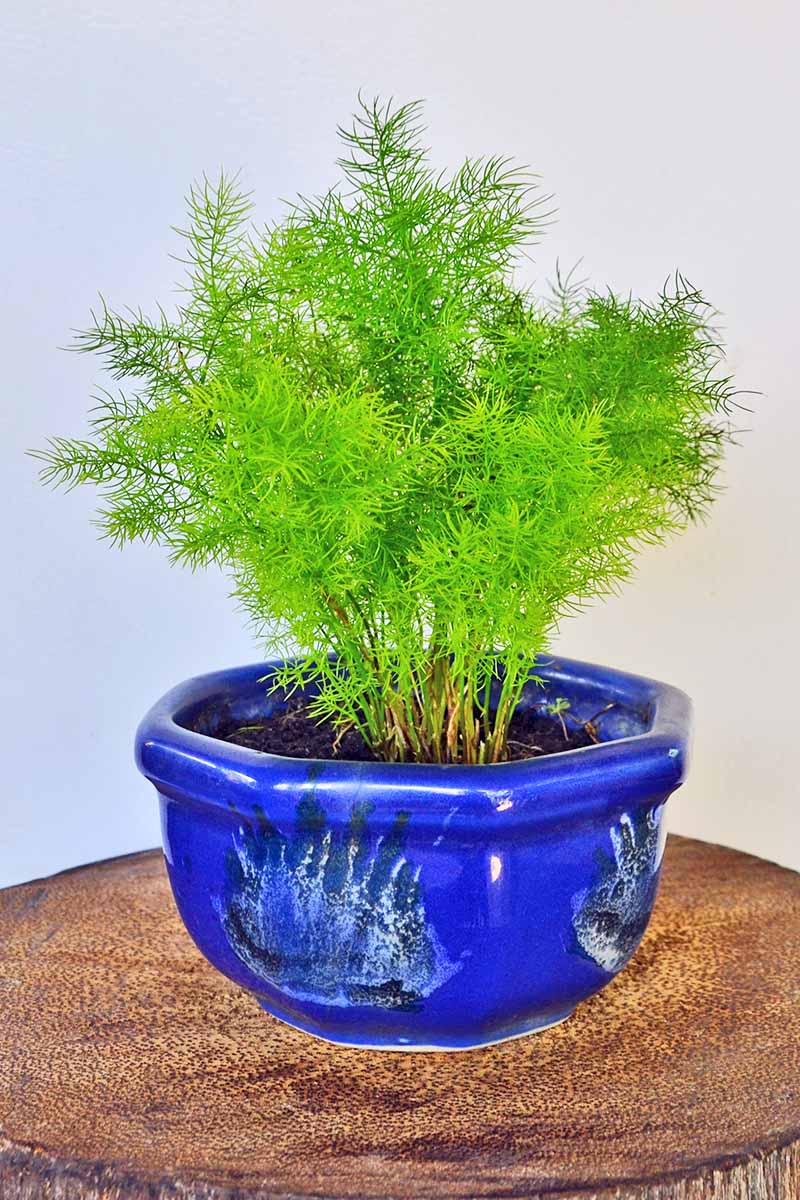
For container gardening, choose a pot that is sturdy, as the root system of this species is vigorous enough to burst right through a thin plastic container. It should be large enough to accommodate the mature width of your plant, which will be noted on your seed packet or nursery pot tag.
Alternatively, you may start small and graduate to larger pots as needed.
Be sure there are adequate drainage holes.
Expect to repot each time your plant’s roots run out of space and begin to poke through the drainage holes in the bottom.
Use an organically-rich potting medium that is slightly acidic, with a pH of 6.5 to 7.0.
Provide indirect sunlight to avoid scorching the foliage and drying out the soil.
Avoid drastic temperature changes and inadequate light, which may cause the cladodes to drop.
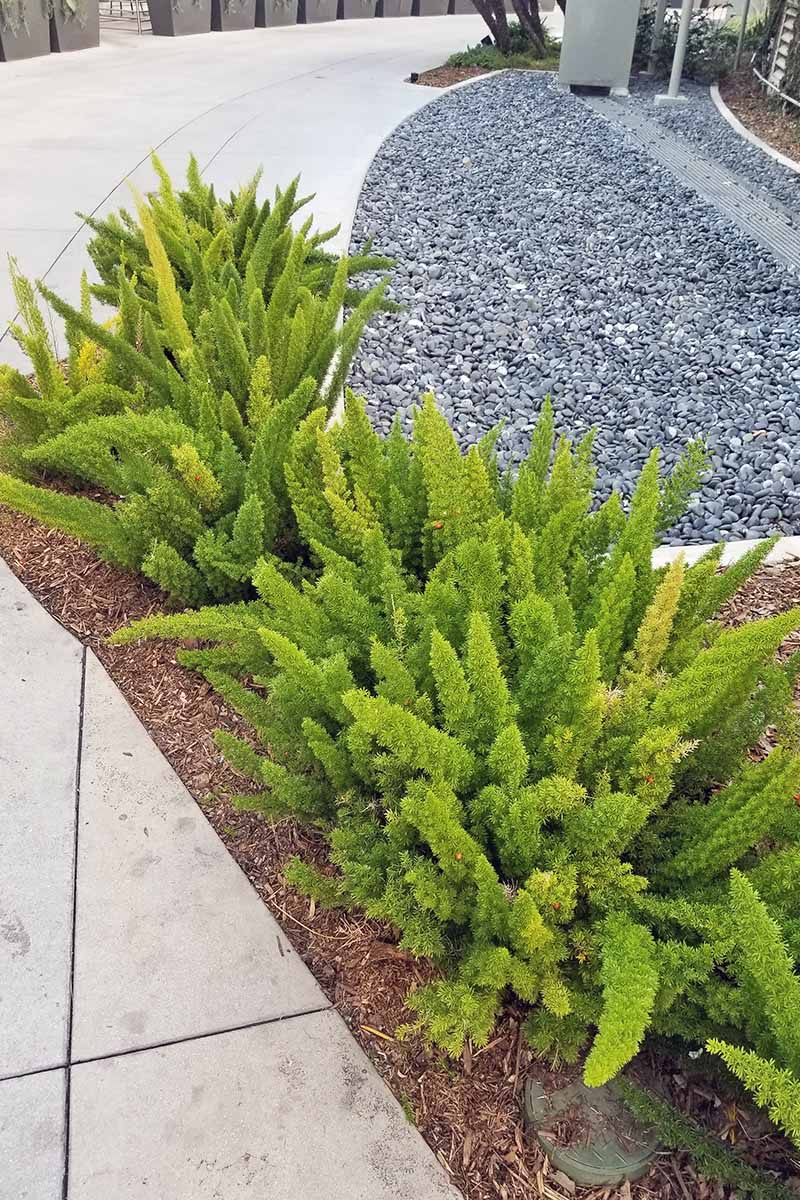
During the growing season, keep the soil evenly moist, but not drenched. In winter, growth slows down and less water is required.
Fertilize lightly with an evenly balanced slow-release houseplant fertilizer, if desired.
You can learn more about caring for houseplants in this guide.
Some folks let the soil dry out between waterings, but you run the risk of causing stress that can result in leaf browning or leaf drop. If cladodes start to turn yellow, water less frequently.
You may keep plants outdoors during temperate months.
To grow in the garden, direct sow seeds or transplant seedlings in the spring to a location with filtered sunlight or afternoon shade.
Maintain even moisture, watering before the soil dries out completely, and supplying approximately one inch per week.
Growing Tips
You won’t find an easier plant to grow when you remember to:
- Maintain even moisture.
- Provide indirect sunlight indoors, and filtered light or afternoon shade outdoors.
- Repot regularly to prevent plants from becoming rootbound.
Take care of its needs, and you will be rewarded with lush growth.
Pruning and Maintenance
Early spring is the best time for evaluating the needs of your plants, both indoors and out.
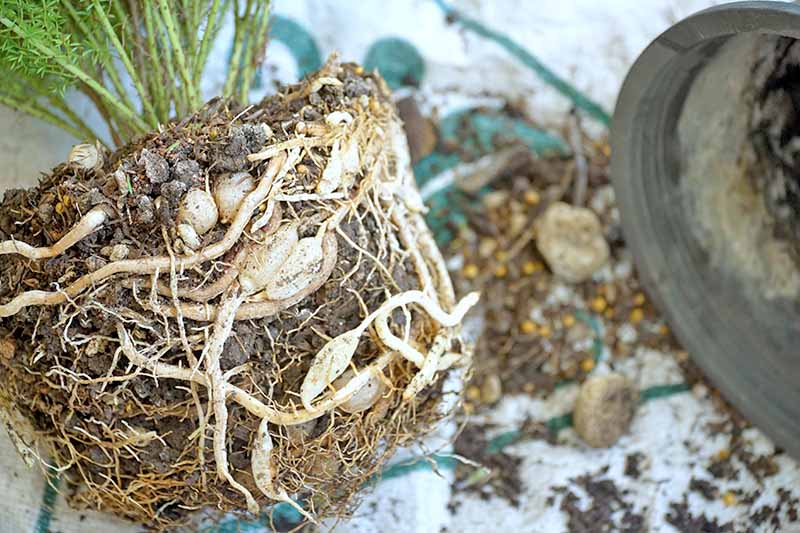
If you find you need to trim away some yellow or brown cladodes, or a stem that is throwing everything off balance, prune at the base of a stem, not at the tip or mid-section.
Periodic pruning of “old wood” keeps stems youthful and fresh.
It’s not uncommon for indoor plants to drop some cladodes during the winter, so keep this in mind when choosing a location for them, as some cleanup may be required.
Now’s the time to decide if you need to repot. While some argue that asparagus fern likes to be pot-bound, I recommend repotting when it becomes so rootbound it begins to burst through the drainage holes.
Choose a container that is a few inches wider and taller than the diameter of the rootstock to allow for room to grow. You may also ease your rootbound plant out of the pot and divide it before repotting it. The divisions make nice gifts for friends.
If you decide not to repot, refresh the old pot with the addition of some fresh potting medium worked into the existing soil.
As the growing season gets underway, begin to fertilize once a month. Discontinue application as fall approaches and growth slows down.
Treat outdoor plants in a similar way. Spring is the time to prune and begin fertilizing. Work some organically-rich compost into your soil, and be vigilant about maintaining even moisture throughout the growing season.
Plants have a tendency to become invasive outdoors, so divide bed and border plants as needed. As an alternative to in-ground planting, consider setting pots of asparagus fern out among specimen plantings to contain their spread.
For more compact growth, you may pinch back the growing tips. And if a plant is completely out of control, you may prune it down to a few inches tall and start over.
In the garden, be sure to weed regularly to reduce competition for water and inhibit pests and disease.
If you’re lucky enough to have blossoms, watch for berries so you can save the seeds to try to start new plants.
When the berries soften and begin to decay, pick them and remove the seeds. Be sure to wear gloves, and keep the harvested berries and seeds away from children and pets.
Wipe off all the berry pulp and allow the seeds to dry thoroughly in a cool, dry location.
Cultivars to Select
The types you are most likely to find for sale at nurseries and garden centers are:
A. densiflorus
There are two common cultivars of the species A. densiflorus, ‘Myeri’ and ‘Sprengeri.’
When shopping for these types, you are likely to come upon variations of their standard species and cultivar names, like A. densiflorus ‘Myers,’ A. densiflorus ‘Myersii,’ A. densiflorus ‘Sprengeri,’ and even A. sprengeri.
Unfortunately, corruptions of the proper botanical names abound, but don’t let them confuse you.
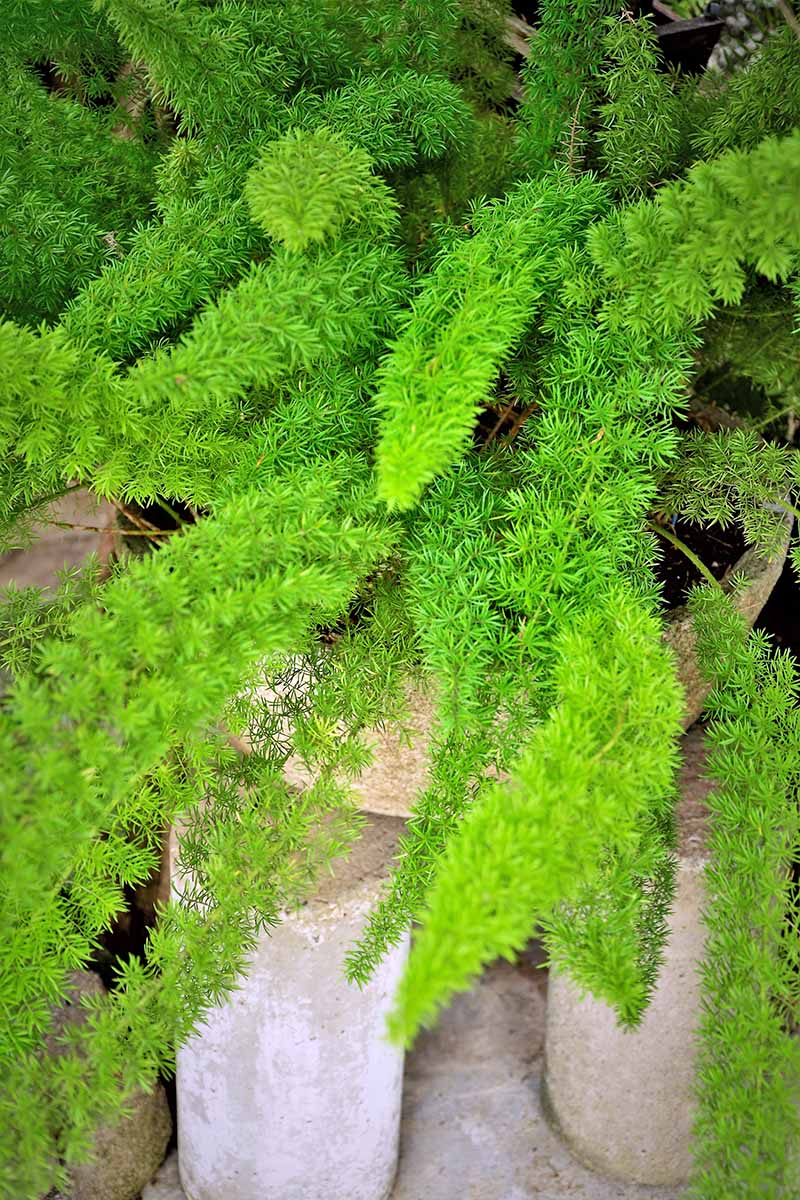
In addition, according to the horticulturists in the Master Gardener Program Division of Extension at the University of Wisconsin-Madison, “the exact classification of this species is a bit confused, with most references to Asparagus densiflorus, but the names A. aethiopicus, A. sprengeri, and Protasparagus densiflorus are also used as well by some.”
Myeri
Also known as foxtail fern, A. densiflorus ‘Myeri’ has a characteristic conical plume shape.
Each stem is densely packed with leaves resembling pine needles and stands distinctly away from the others like the fluffy tail of a fox, hence the name.
White flowers may appear in the summer, followed by red berries in the fall.
Texturally-rich foxtails top out at two feet tall, with a spread of three to four feet.
Packets of 100 A. densiflorus ‘Myerii’ seeds are available from True Leaf Market.
Sprengeri
Often called emerald fern, A. densiflorus ‘Sprengeri’ has a mounding habit, and airy foliage that resembles small pine needles on gracefully arching stems.

Mature specimens become almost woody.
They may bear white blossoms followed by red berries, depending upon gender, a characteristic that’s seldom known in advance by the purchasing consumer.
Delicately arching stems may produce white or pink blossoms, and berries that turn from green to red in winter. This variety has a mature height of one to two feet tall, and a spread of three to four feet.
A. sprengeri seeds are available from True Leaf Market.
A. retrofractus
Also known as A. myriocladus, A. aethiopicus ‘Myriocladus,’ or A. macowanii, this is a lacy kind frequently used in cut floral arrangements.
A. retrofractus is sometimes called pom-pom asparagus fern because needle-like leaves appear sporadically in clusters along slender stems.

It’s also referred to as zig-zag fern, because of the interesting back-and-forth arrangement of its branches. White blossoms leading to orange berries that mature to black may appear.
This type typically achieves a mature height of two feet.
A. setaceus
Also known as Protasparagus setaceus or A. plumosus, A. setaceus is a twisty climber that bears the closest resemblance to a typical fern, in my opinion.
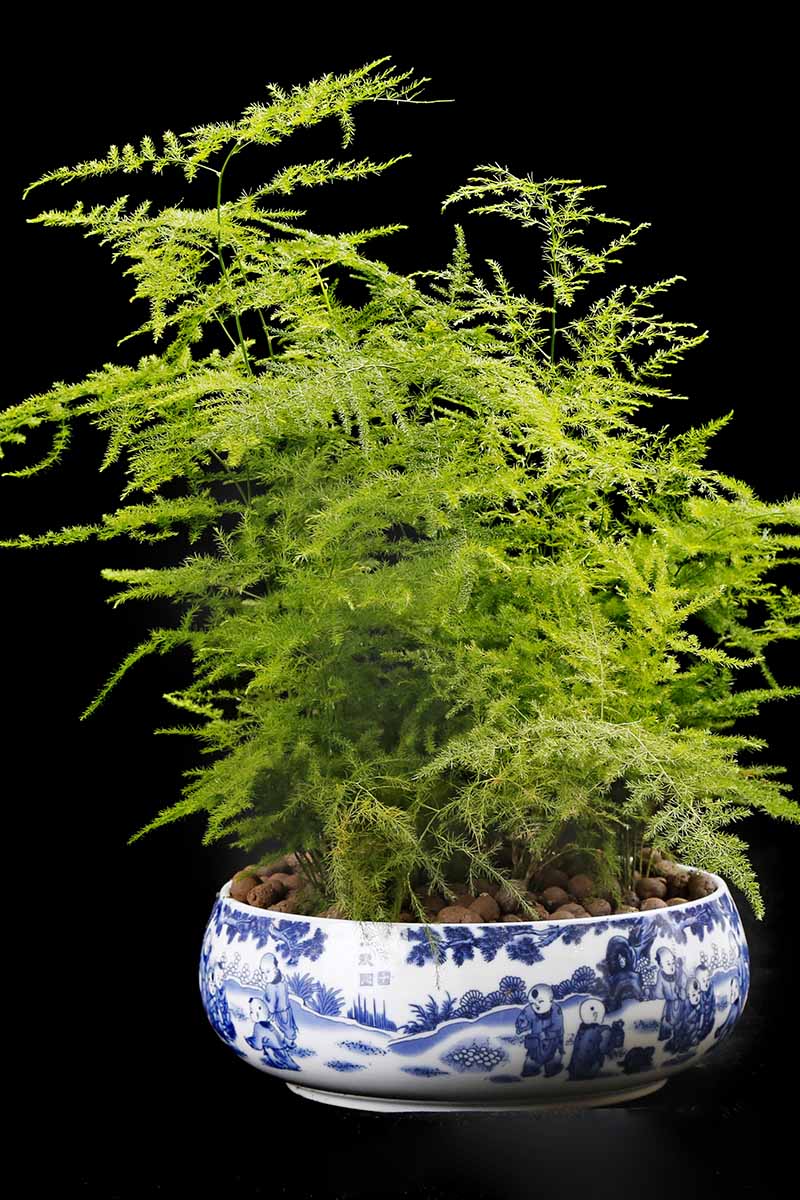
Cladodes like the finest pine needles adorn stems in a triangular pattern.
Nanus
This cultivar has a more compact growth habit that makes an eye-catching ground cover.
It grows to a mature height of one and a half to two feet, with a spread of two to three feet.
A. plumosa ‘Nanus’ seeds are available from True Leaf Market. Each package contains 100 seeds.
Please keep in mind that vigorously growing asparagus ferns planted outdoors may become invasive in certain climates. Also, most won’t perform well in temperatures below freezing.
Again, we never know if we’re getting a male or female plant, and while both may produce nondescript blossoms under optimal conditions, only females set fruit.
Managing Pests and Disease
Barring temperature extremes, and with proper lighting and water, you should experience few disease or pest issues with asparagus fern.
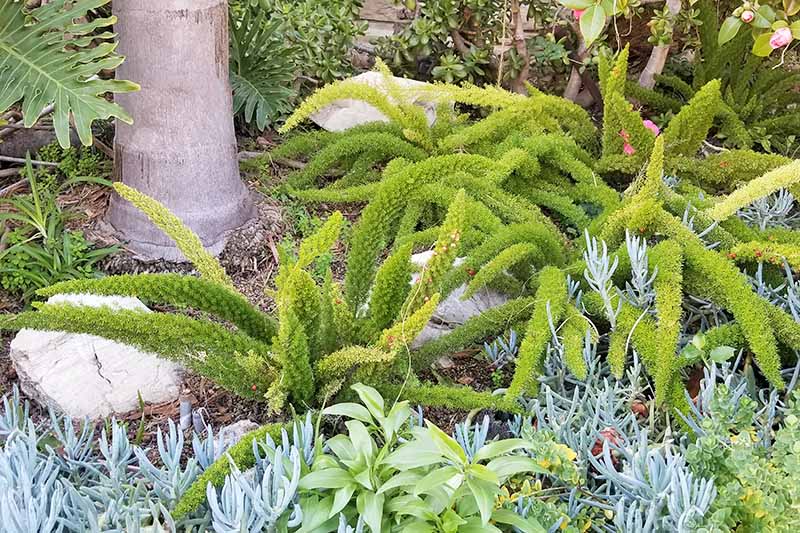
Stress from over- or under-watering may create the right environment for aphids, mealybugs, spider mites, and whiteflies to infest the plants.
Use an insecticidal soap or neem oil to remedy the situation, and don’t hesitate to fertilize lightly and prune hard for a fresh start.
In addition, you may attract slugs if conditions are too wet, so avoid excess moisture, and use methods such as bait, barriers, and traps if they are a problem.
As for disease, overly wet conditions may invite fungal conditions such as:
All three may present themselves when conditions are too wet, and may be addressed with fungicides.
Best Uses
This plant offers everyone the ability to enjoy it indoors as a houseplant.
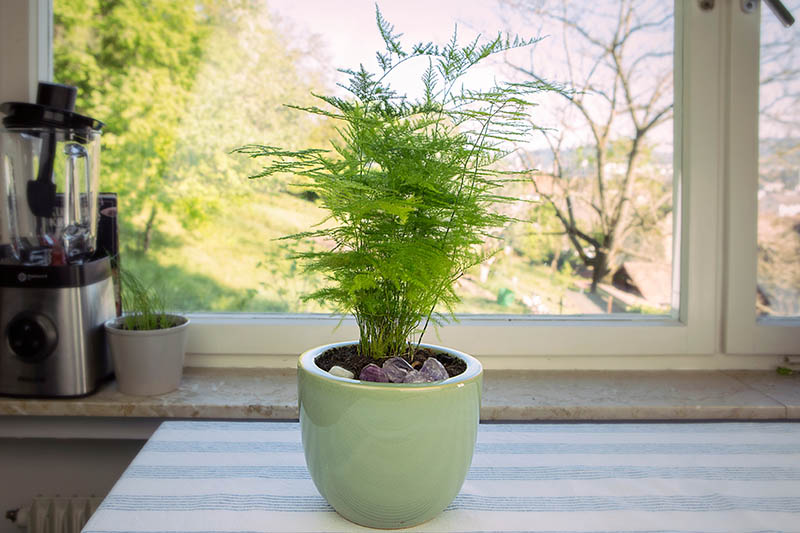
In Zones 9 to 11, except where it is known to be invasive, you may add it to your year-round outdoor living space.
Those in other regions, where the summers are warm, may give their houseplants a yearly airing.
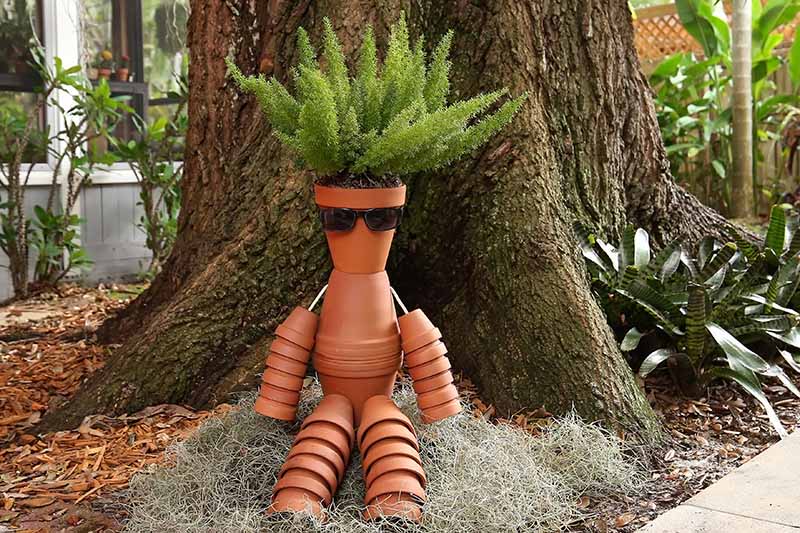
This showy plant is especially attractive in suspended planters both indoors and out.
Growing in containers controls spreading and lets you mix and match plants with different watering requirements.

The emerald green hue and texturally-rich, needle-like cladodes give asparagus fern varieties an ephemeral quality that adds visual interest to gardens, where it naturalizes readily.
Quick Reference Growing Guide
| Plant Type: | Evergreen herbaceous perennial | Flower / Foliage Color: | White/emerald green |
| Native to: | Southern Africa | Tolerance: | Drought (moderate) |
| Hardiness (USDA Zone): | 9-11 | Maintenance: | Low |
| Bloom Time / Season: | Summer | Soil Type: | Organically-rich |
| Exposure: | Filtered light, indirect light, part shade | Soil pH: | 6.5-7.0 |
| Spacing: | 3-5 feet | Soil Drainage: | Well-draining |
| Planting Depth: | 1/8 inch | Attracts: | Birds |
| Height: | 2-8 feet | Uses: | Indoor and outdoor containers, naturalizes rapidly in beds and borders |
| Spread: | 2-5 feet | Family: | Asparagaceae |
| Growth Rate: | Fast | Genus: | Asparagus |
| Water Needs: | Moderate | Species: | densiflorus, retrofractus, setaceus |
| Common Pests: | Aphids, mealybugs, scale, slugs, spider mites, whiteflies | Common Disease: | Crown rot, leaf spot, root rot |
Beauty and Braun
It’s time to add an asparagus fern or two to your indoor decor, or temperate outdoor living space. Choose locations with indirect, filtered, or part sun for best results.
Don’t hesitate to prune your plants hard to maintain their attractive forms. Despite their delicate appearance, you’ll find they are powerhouses that provide years of vigorous growth and textural appeal.
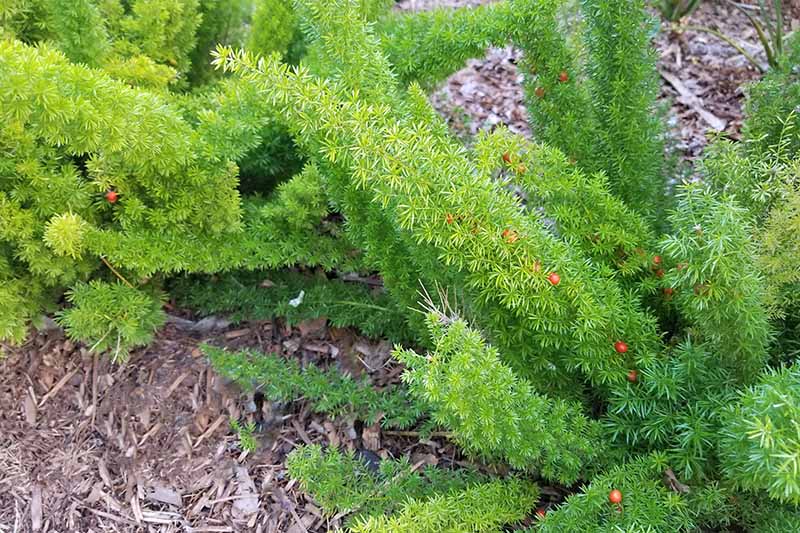
Display them in hanging containers on a patio for a cascading effect, or let them trail across a shelf or accent table.
No matter where or how you feature these sturdy, low-maintenance ornamental specimens, they are sure to delight you and visitors to your home with their gentle beauty.
Are you growing asparagus fern? Let us know in the comments below and feel free to share a picture!
For more indoor gardening ideas, try these articles next:
- The Best Tips for Cultivating Showy Garden Croton Indoors
- The Top 11 Mushroom Growing Kits for Home Gardeners
- How to Become a Succulent Pro
Photos by Allison Sidhu, © Ask the Experts, LLC. ALL RIGHTS RESERVED. See our TOS for more details. Originally published February 20, 2019. Last updated June 12, 2020. Product photos via Hirt’s Gardens and True Leaf Market. Uncredited photos: Shutterstock.
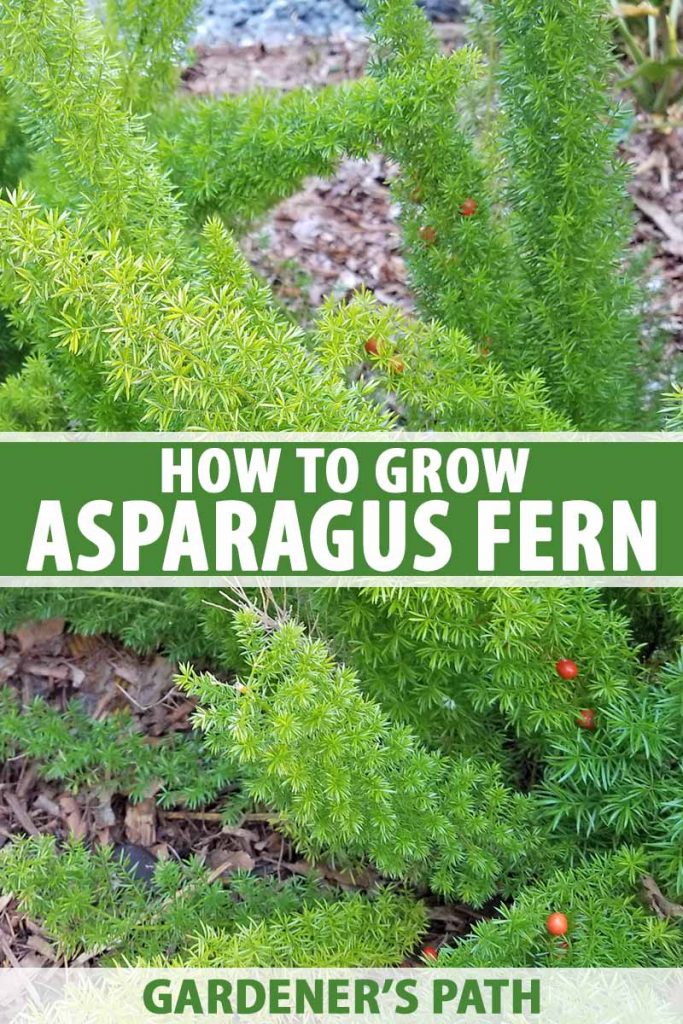

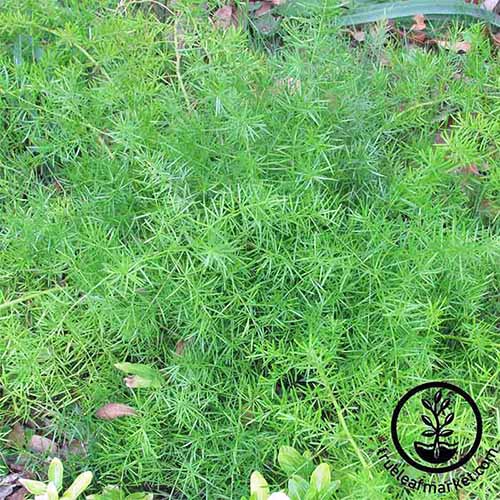
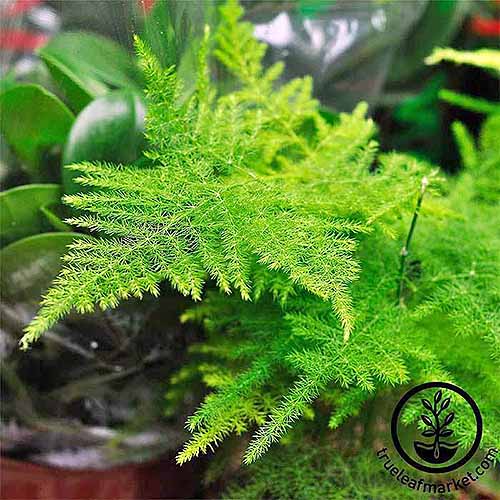
Can this Fern be divided?
Yes, absolutely! Asparagus ferns like to be a bit pot-bound, but nonetheless, they can quickly outgrow their containers. It’s a good idea to divide as needed every couple of years, to promote the health of the plant. It may be difficult to tease the extensive root system apart. Wearing gloves, unpot the plant, gently shake off as much dirt as you can, and unwind the roots with your fingers. You can use a clean gardening knife if you have to, just make sure each portion that you divide maintains some intact roots. Don’t worry too much about any that are… Read more »
I cut a bunch of the root ball off, totally overgrown, and stuck them in dirt. Any chance of growing?
Yes, asparagus ferns can be divided. Hopefully yours will start sprouting new shoots soon!
I did the same thing as Kathleen, cut lots of roots & planted. I live in So Cal. We had a heatwave, they got full sun and it’s starting to yellow and brown. Moved them to new location to get morning sun only. How often should I water, should I prune off dead branches… is there hope for survival?
Hi SueAnn – Asparagus ferns are pretty tough. Mist once or twice a day. Water often enough to keep the soil moist, but not soggy. Never let it completely dry out.
Hi. I just repotted mine today. Thanks for this amazing article.
You’re welcome, Terry. Love the planters!
I’ve attached my picture of my plant, this is the time I’ve grown this plant. I love how airy this plant is. It doubled in size and is very healthy on the East side of my house.
I’m not sure if I should bring it in over the Winter and if so, where I should store it?
Hi Tina –
If you live in USDA hardiness zones 9 to 11, you may leave your beautiful plant outdoors year-round. If you need to bring it indoors, choose a location with indirect light. Ideally, the daytime temperature will be about 70°F and the indoor humidity will be about 40% to 50%. Mist your plant daily and water when the top half of the soil dries out.
I woul like to grow asparagus vergatus as a cut foliage.how long will it take from seeds to first cut .
Hello Symon –
The lovely photo you have included appears to be that of a pomegranate tree that is doing quite well.
Asparagus virgatus, or broom asparagus, known for it’s longevity in floral vase arrangements, as well as for its potential to become invasive, is a slow-growing evergreen perennial that reaches a mature height of approximately three feet tall and two feet wide in five to 10 years.
What does the asparagus fern do to animals?
Hello Rosaura –
Asparagus fern is toxic to dogs and cats. It causes gastrointestinal symptoms including vomiting and diarrhea. If your pet ingests plant material, contact an emergency vet immediately.